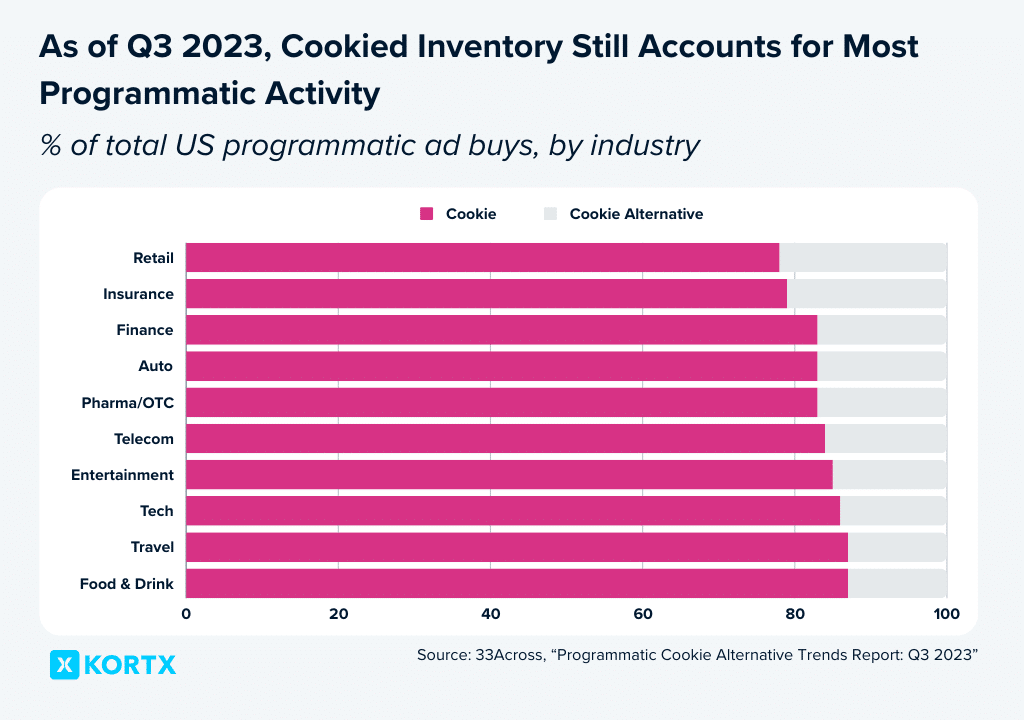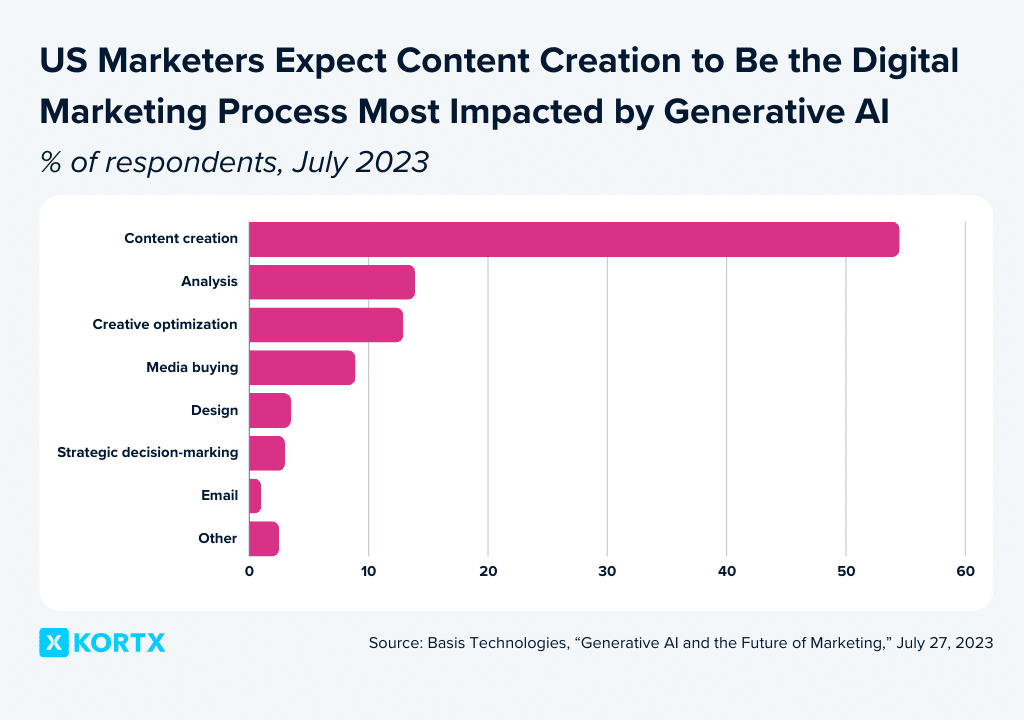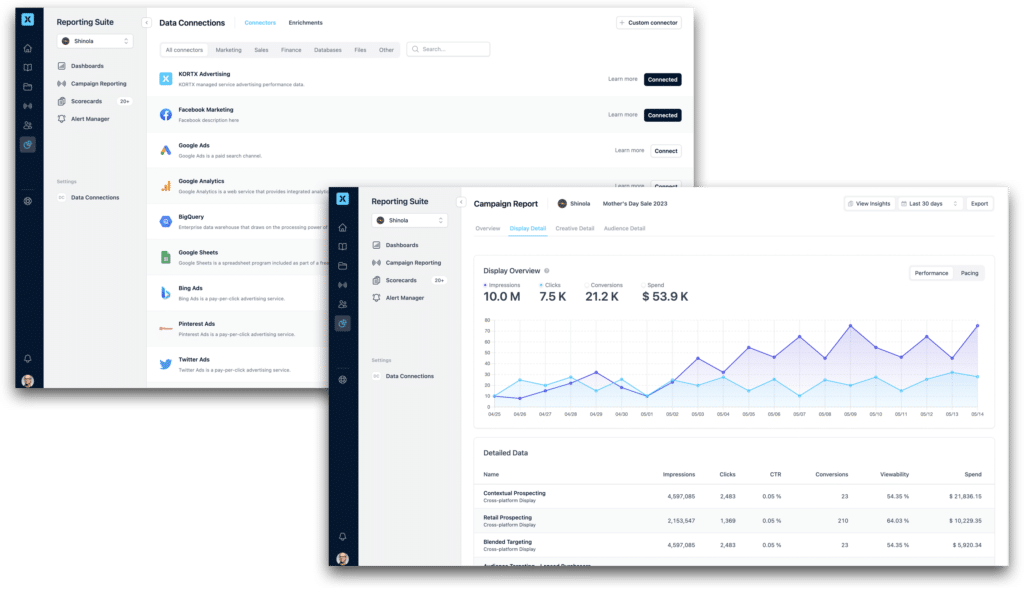Third-Party cookie deprecation isn’t the end of the road for programmatic advertising advancement.
New technologies and strategies emerge as we move away from traditional cookie-based tracking. This evolution brings challenges and opportunities, urging advertisers and publishers to adapt to a more consent-based, transparent framework.
Explore the programmatic trends to watch in 2024, including alternative data solutions and how the industry can pivot to maintain relevance in a post-cookie era.
Programmatic Advertising Trends Shaping the Industry in 2024
2024 marks a pivotal shift towards more privacy-centric and innovative approaches in the industry. These nine trends are redefining programmatic advertising.
1. Marketers Must Find New Solutions to a Post-Cookie Era
With the deprecation of Third-Party cookies on the horizon, no single source solution will replace the cookie’s role.
A combination of new audience targeting and attribution/measurement capabilities will need to be tested, adopted, and integrated into future digital marketing strategies.
Will these “siloed” solutions work harmoniously and provide the same seamless and efficient outcomes as a cookie dropped on a browser? No one knows as we enter 2024, but it will be quite the ride while we find out.
It shouldn’t come as a surprise, as cookies have been on borrowed time since 2022. And as of Q3 2023, cookied inventory still accounts for most programmatic activity.

A third of brands, agencies, publishers, and other advertisers worldwide believe Google will delay cookie deprecation again, but Google has a concrete roadmap to phasing them out in Q1 2024.
2. Targeting Will Shift to Being Publisher-Driven
This is a crucial time for publishers to evolve, capitalizing on their direct user access to create targeting strategies that once relied on cookies.
Publishers’ First-Party data is now extremely valuable, whether used for creating specific audience groups from logged-in website visitors or forming likely audience segments through algorithms using lots of data.
Advertisers increasingly use machine learning and Artificial Intelligence (AI) to improve targeting and measurement. These models can create advanced systems that combine different sets of known audience data (deterministic data) and help identify unknown audience segments.
Though solutions may be available on the largest publishers for the largest brands or media buyers, few, if any, publisher audience targeting solutions have trickled down to small and medium-sized brands and agencies.
3. First-Party (1P) Data is a Brand’s Most Powerful Asset
Every brand’s website is its digital store, and the visitors to those online stores must be treated as the most important data set available.
With the removal of common online identifiers, brands must focus on collecting, organizing, and analyzing their digital customers’ data, like their characteristics, behaviors, and interests. This is key to getting the most value from digital marketing spend.
Using artificial intelligence (AI) and combining algorithms with customer data will lead to more accurate targeting and a better understanding of the brand’s unique audience.
Tools (like KORTX’s Axon Audience Manager) can identify potential customers who share characteristics with existing customers (lookalike audiences), offering a viable alternative to traditional tracking methods like Third-Party cookies.
Investing in the digital infrastructure that allows brands and agencies to activate those datasets will intensify, especially as AI picks up speed in 2024.
How does using First-Party data improve advertising campaigns and user experience insights?
“Beyond driving campaign results and efficiencies, leveraging your 1P data provides other benefits, including giving advertisers an in-depth look into user experience, including potential opportunities, drop-off points, trends, intent, etc. When there is synergy between the campaign plan, KPI, creative, and user experience, we will be able to drive the most effective business outcome.”
4. Predictive Creative Optimization (PCO) Will Improve Ad Selection & Optimization
Integrating advanced machine learning models into Predictive Creative Optimization (PCO) will change how ads are selected and optimized.
A key strength of PCO machine learning models is their ability to learn from new data continuously. As consumer behaviors and market trends shift, the models adapt, and the ad creatives stay relevant and effective.
One of the primary goals of PCO is to maintain the relevance of ad creatives to the target audience. As the models evolve and learn, they ensure that the messaging, tone, and visual elements of ads align with the audience’s current interests and needs.
Example: A clothing brand’s PCO system automatically shifts its ad focus from vibrant summer outdoor beach scenes to cozy winter indoor settings, aligning with seasonal consumer preferences for better engagement.
5. AI Will Significantly Enhance Ad Creative Production
Like PCO, automated creative production through AI will greatly enhance personalization and optimize resource use. This will change how creative content is created and used across different platforms.

For instance, ad designers can focus on developing strategic creative concepts rather than reforming ads to fit various dimensions.
AI can also help brands maintain brand consistency across channels. Advertisers can use AI to edit a creative’s messaging and tone, reinforcing a cohesive experience across every audience interaction.
6. Marketers Must Unify Cross Channel Campaigns
Display, online video (OLV), audio, pDOOH (programmatic digital out-of-home), and connected TV (CTV) campaigns executed by multiple vendors are becoming increasingly untenable.
This fragmentation hinders the ability to target audiences with responsible frequencies and severely compromises cross-channel attribution. This leads to inefficient use of resources and difficulty in measuring marketing impact.
Marketers who can unify their strategies, execution, and measurement on as few platforms as possible have realized great growth in 2023 and are best positioned to continue that success in 2024.
7. Unified Data Dashboards Will Be the Key to Brand-Marketer Collaboration
Having a unified view of all digital marketing results, including key performance indicators, target audiences, locations, creative content, devices, mediums, channels, strategies, conversions, and revenue, is now a fundamental industry requirement.
Advertising technology software, like KORTX’s Kampus, that integrates the previously siloed platforms into a transparent, real-time visualization tool will continue to help brands realize impactful marketing spending.

A preview of a Kampus dashboard.
Stronger partnerships will form between marketers and brands by constantly analyzing and discussing ongoing campaigns on one dashboard. Open and honest communication builds trust, reducing worries about conflicting interests.
Personalized reporting, such as dashboards, makes data more accessible. Team members without strong data backgrounds can generate insights independently.
Generative AI (GenAI) will likely integrate into various data reporting software to break down data and explain patterns in simple terms for non-data scientists.
Advertisers who keep up with brands’ needs and develop new software will stand out in 2024.
📚 Related article: Introducing Kampus: A Marketing Platform from KORTX: Learn how Kampus, an innovative platform, helps you streamline your digital marketing efforts, all from a single dashboard.
8. Connected TV (CTV) Will Continue to Grow
CTV spending was $25.09 billion in 2023, poised to jump to $29.29 billion in 2024. As more and more cut the cord on linear, streaming subscription OTT (over-the-top) revenue continues to soar, from $8.55 billion in 2023 to $10.24 in 2024.
Virtually all major streaming services, like Netflix, Disney+, and Hulu, are adding ad-supported subscription tiers. FAST (Free Ad-Supported TV) viewership grew by 103% in 2021, projected to grow 30.5% from 2023.
Programmatic advertising has also evolved to reflect this trend, with three-quarters of ad spending going to both mobile and CTV devices.
Innovations like interactive CTV advertising are becoming more popular as advertisers want to find additional creative ways to engage viewers with ad content and hold their attention.
AI could also significantly shape CTV in a few ways:
- Personalized Ad Experiences: Tailored ads to individual viewers based on their viewing habits and preferences.
- Real-time Content Optimization: Altering ad content without manual intervention in real-time for increased relevance and engagement.
- Ad Placement: Smarter programmatic ad buying, ensuring ads reach the most appropriate audience segments.
- Advanced Analytics: Providing deeper insights into viewer behavior and ad performance, enabling more effective campaign adjustments.
📚 Related article: AI in Programmatic Advertising: Read more about how AI is shaping the future of programmatic advertising with 6 key trends.
9. Advertisers Will Shift Focus to Contextual Advertising
As access to deterministic consumer data diminishes, the value of contextual information is soaring, leading advertisers to recalibrate their strategies.
A Proximic survey from March revealed that over half of US marketers planned to increase their contextual data use in 2023.
Contextual advertising, which matches ads with relevant content using clear metadata and taxonomy, is gaining popularity among advertisers due to its precise targeting during the bidding process.
In Connected TV advertising, advertisers are showing more interest in specifically knowing the streaming or TV shows where their ads are placed. Contextual advertising can match ads with relevant shows, so ads appear alongside content aligning with their product or message.
How Can Advertisers Maximize Their Programmatic Strategies in 2024?
As we move into 2024, advertisers must strategically adapt to a programmatic landscape, especially without Third-Party cookies.
Here are some tips to stay ahead:
1. Proactively Prepare for a Cookie-less Future
Don’t rely on extensions to cookie deprecation timelines; treat them as temporary reprieves. Instead, utilize the current lack of Third-Party cookies in major browsers as an opportunity to gather audience insights.
Explore Google’s Privacy Sandbox initiatives to stay prepared for the inevitable shift.
2. Choose Your Partners Wisely
Not all ad tech vendors will survive these Third-Party cookie changes. Conduct thorough evaluations of potential partners and regularly review existing relationships. Prevent future complications and financial losses by conducting this due diligence.
3. Monitor Inventory Quality Closely
As generative AI (genAI) becomes more prevalent, distinguishing high-quality content will become increasingly challenging. Set clear brand suitability thresholds and risk tolerance levels.
In case of any issues, consider employing inclusion lists or a more comprehensive, always-on contextual targeting approach, possibly enhanced with AI and attention metrics.
4. Leverage First-Party Data
Emphasize collecting and utilizing First-Party data to gain deeper insights into customer behaviors and preferences. Tools like Axon Audience Manager allow you to build your own First-Party audiences by collecting data directly from your customers across your brand’s website.
Read our First-Party data guide to learn how to collect your own First-Party data.
5. Use a Unified Data Dashboard
Aggregate and analyze all data sources from a single dashboard. Dashboards foster stronger partnerships between marketers and brands by helping with continuous analysis and open communication. They also make data more accessible to team members with varying levels of data expertise, allowing for independent insight generation.
KORTX’s Kampus can aggregate your campaign data in one place, including campaign reporting, ad creative previews, and other important insights.
Learn more about how Kampus can centralize your data in one easy-to-access dashboard.
Centralizing your data helps you make informed decisions, streamline workflow, and ensure consistency in marketing strategies across different channels and platforms.
Embracing the New Era of Programmatic Marketing Trends in 2024
2024 presents an opportunity for advertisers to redefine their strategies and forge a more responsible and customer-centric approach to programmatic advertising. As we step forward, the industry’s ability to adapt and innovate in a post-cookieless world will determine its immediate success and shape its long-term sustainability.
About the Author
Bryan Presti is the Head of Programmatic Trading at KORTX.


